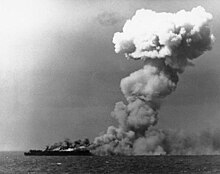
Back Slag van Leytegolf Afrikaans معركة خليج ليتي Arabic Битка в залива Лейте Bulgarian Batalla del golf de Leyte Catalan Bitva u Leyte Czech Лейте кӳлмекĕнчи çапăçу CV Slaget om Leyte Gulf Danish See- und Luftschlacht im Golf von Leyte German Ναυμαχία του Κόλπου Λέιτε Greek Batalo de Lejtea Golfo Esperanto
| Battle of Leyte Gulf | |||||||
|---|---|---|---|---|---|---|---|
| Part of the Philippines campaign (1944–1945) of the Pacific Theater of World War II | |||||||
 The light aircraft carrier Princeton on fire, east of Luzon, on 24 October 1944 | |||||||
| |||||||
| Belligerents | |||||||
|
| |||||||
| Commanders and leaders | |||||||
| |||||||
| Units involved | |||||||
| Strength | |||||||
|
| ||||||
| Casualties and losses | |||||||
|
| ||||||
The Battle of Leyte Gulf[5] (Japanese: レイテ沖海戦, romanized: Reite oki Kaisen, lit. 'Leyte Open Sea Naval Battle', Filipino: Labanan sa Golpo ng Leyte) was the largest naval battle of World War II and by some criteria the largest naval battle in history, with over 200,000 naval personnel involved.[6][7][8][9] It was fought in waters near the Philippine islands of Leyte, Samar, and Luzon from 23 to 26 October 1944 between combined American and Australian forces and the Imperial Japanese Navy (IJN), as part of the invasion of Leyte, which aimed to isolate Japan from the colonies that it had occupied in Southeast Asia, a vital source of industrial and oil supplies.
By the time of the battle, Japan had fewer capital ships (aircraft carriers and battleships) left than the Allied forces had total aircraft carriers in the Pacific, which underscored the disparity in force strength at that point in the war.[10] Regardless, the IJN mobilized nearly all of its remaining major naval vessels in an attempt to defeat the Allied invasion, but it was repulsed by the US Navy's Third and Seventh Fleets.
The battle consisted of four main separate engagements (the Battle of the Sibuyan Sea, the Battle of Surigao Strait, the Battle off Cape Engaño, and the Battle off Samar), as well as lesser actions.[11] Allied forces announced the end of organized Japanese resistance on the island at the end of December.
It was the first battle in which Japanese aircraft carried out organized kamikaze attacks, and it was the last naval battle between battleships in history.[12][13] The Japanese Navy suffered heavy losses and never sailed in comparable force thereafter since it was stranded for lack of fuel in its bases for the rest of the war.[14][15]
- ^ Morison 1958, pp. 415–429.
- ^ Thomas 2006, pp. 209–210.
- ^ Tillman, Barrett (October 2019). "The Navy's Aerial Arsenal at Leyte Gulf". Naval History Magazine. Vol. 33, no. 5. United States Naval Institute. Retrieved 1 January 2022.
- ^ Thomas 2006, p. 322.
- ^ Filipino: Labanan sa golpo ng Leyte, lit. 'Battle of Leyte gulf'
- ^ Cutler, Thomas J. (1994). "Greatest of All Sea Battles". U.S. Naval Institute. Retrieved 8 April 2024.
The Battle of Leyte Gulf was the biggest and most multifaceted naval battle in history. It involved hundreds of ships, nearly 200,000 participants, and spanned more than 100,000 square miles.
- ^ Woodward 2007, pp. 1-3.
- ^ Roberts, Andrew (2012). The Storm of War: A New History of the Second World War. HarperCollins. p. 565. ISBN 978-0-06-122860-5.
The counter-attack at Leyte Gulf in late October 1944, with a carrier force from Japan and strike forces from Brunei, turned into the largest naval engagement in world history, with 216 United States Navy (and two Royal Australian Navy) vessels comprising 146,668 men doing battle with sixty-four Japanese vessels totalling 42,800 sailors and airmen.
- ^ Hanson, Victor Davis (2020). The Second World Wars: How the First Global Conflict Was Fought and Won (Reprint ed.). New York: Basic Books. p. 194. ISBN 978-1541674103.
Later at the Battle of Leyte Gulf (October 24–25, 1944), which was likely the largest sea battle in naval history in terms of the combined tonnage of the some 370 ships,
- ^ Thomas 2006, p. 123.
- ^ "Battle of Leyte Gulf". World War 2 Facts. Retrieved 17 January 2014.
- ^ Morison 1958, pp. 101, 240–241, 300–303.
- ^ Fuller 1956a, p. 234.
- ^ Fuller 1956b, p. 600.
- ^ Morison 1958, pp. 360, 397.
© MMXXIII Rich X Search. We shall prevail. All rights reserved. Rich X Search